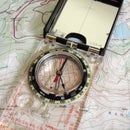Introduction: Birch and Aluminum Desk
This desk was designed to meet specific needs- it had to be:
1) Large enough to spread out a textbook, notebook computer, and writing notebook.
2) Durable, with legs that do not wobble or a span that bends under weight.
3) Without nooks and crannies that would fill up with knick knacks.
4) Modern, clean, stylish and a positive addition to my workspace.
My finished product has douglas fir legs, a birch top with steel panels and an acrylic overlay. The edges are finished with aluminum angle.
And so we begin with the materials:
1 4x8' 3/4" Birch Plywood
1 3x6' 0.118" Acrylic Sheet
1 12' 4x4" Douglas Fir
2 8' 1" Aluminum Angle
12 8x12" Galvanized Steel Flashing in Pre-cut sections
10 3/4" #8 Stainless Screws
4 4" 3/8" Hanger Bolts
4 3/8" Tee Nuts
1 Can Polyurethane Finish
Double Stick Tape
Glue
Wide Tape
Aluminum Polish
Car Wax
Tools:
Circular Saw
Jigsaw
Square
Tape Measure
Drill with various drivers and bits
Router
Tin Snips
Step 1: Plan and Cut to Size
This step was relatively simple for me, as my steel panels were 8x12". My final dimensions for the top were therefore 32x60".
But layout a design on your available plywood and see what works best. With an acrylic top, you can put nearly anything underneath, I considered pictures, lights and many other designs.
I used a circular saw to cut the plywood down, a table saw or hand saw would work just fine as well.
Step 2: Cut Legs to Length
This is the step you'll feel the most once you have your finished product. The best advice is to find a table you like the height of, and copy the leg length. I cut my legs to 29", and they're just on the edge of being too long. But I'm a tall guy, and with an adjustable chair it's very comfortable- if anything a taller desk forces you to sit with better posture.
When working with a 12' beam, we chose to cut it into quarters, then down to our desired size. Wasteful yes, but easier to manage and keep square.
Step 3: Cut Acrylic to Match Top
Keep the plastic on the acrylic to the very end- it'll stay clean and shiny. Lay the acrylic over top of the plywood, then use a flush trim bit on a router to match the top to the plywood.
If you don't have a router, a circular saw or even wood saw would be just fine.
Step 4: Cut and Bend Aluminum Edges
Now you'll cut your aluminum angle to match your plywood. Measure your spans, we chose to use two eight footers, cut and bent at 16" 60" and 16". This places your seems at the sides, away from your elbows while working.
To cut the aluminum, measure out a 90 degree angle, and cut it out with the jigsaw. Then clamp to a right angle, and gently bend to 90.
Step 5: Drill Holes for Legs
Now you'll drill four holes in the plywood These should be just a tad over 3/8" to accommodate the Tee nuts, and should be countersunk about 1/16". I brought the legs six inches in, and two inches from the front.
A better plan would be to go a few inches further from the front, so that the legs can be rotated and removed without removing the aluminum angle.
Once you drill the holes, put a small amount of glue around the hole and gently pound in the nuts.
Step 6: Drill Holes in Legs
Here you'll drill holes a tad smaller than 3/8" for the hangar bolts. Drill in the center of the 4x4.
Screw in the hanger bolts by placing two nuts on the threaded section to act as jam nuts, then use a hex wrench or ratchet to screw them in to the desired depth.
Step 7: Apply Finish
Next you'll want to sand all of your wood pieces, starting at about 100 grit to remove machining marks, then to 220 and finally 320 before the first coat of finish. Brush off the dust, and wipe down with tack cloth to prep the surface.
Suspend all of your pieces for finishing, and apply finish with roller or brush. Be sure to stir your finish of choice.
Once dry, sand with 320 grit or finer, clear off the dust, then apply a second coat. Apply as many coats as necessary, we put four coats on because the polyurethane went on a little thin.
Step 8: Attach Legs and Metal Panels
I don't have any pictures, but you'll just have to trust me that the legs screw into the embedded Tee nuts. Snug them up and square them off to the sides of the desk.
Layout the steel panels in desired pattern, then tape them down with double stick tape. You could glue them, but tape allows you to remove them or rearrange them should you choose.
Step 9: Drill Holes for Aluminum Angle
Next you'll want to layout your aluminum edging, and choose where to place your screws.
We chose to put all of the screws on the topside to prove the most structural support. We put three across the front, then one on either side of the joint on the side.
Drill a pilot hole first, to avoid cracking the acrylic, then finish with a larger hole so the screw doesn't have to chew through the aluminum and acrylic. It should be shallow enough to allow the screw to anchor into the plywood.
Put all the screws in to test fit, then polish with a metal polish. Finish the polish off with car wax to keep the aluminum from oxidizing.
Step 10: Clean Surface and Lay Down Acrylic
First, remove the polished aluminum edge and acrylic. Clean the surface, and remove any grime from the steel panels. Peel off the down-facing film on the acrylic, then lay it on the table. Peel off the topside film- this moment is glorious! Suddenly the desk is brilliantly shiny.
Screw down the edging, and you're finished!
Step 11: Finished Product
I suppose you're not finished until you admire yourself in your shiny new desk. Polish it up, then install it in your workspace!
Suggestions, questions and comments welcome and appreciated. Have fun building your own custom desk!











